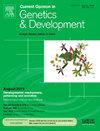神经发育障碍的转录-输出复合体
IF 3.6
2区 生物学
Q2 CELL BIOLOGY
引用次数: 0
摘要
基因组信息被隔离在所有真核细胞的细胞核中。无错误转录需要信使rna (mRNA)的有效输出,以促进执行细胞功能的蛋白质的调节合成。功能保守的转录-输出(TREX)复合体是介导mRNA从细胞核输出到细胞质的关键角色,与RNA加工步骤一起,包括3 ‘端加工,5 ’盖帽,转录调节,r -环分辨率和剪接。TREX是一种多功能复合物,在应激反应、有丝分裂进程、胚胎干细胞自我更新和分化、维持基因组稳定性等方面具有重要作用。这些过程中的大多数对于大脑的正常发育和功能是必不可少的。与这一观点一致的是,TREX组分THOC2、THOC6和DDX39B功能变异的部分丧失与神经发育障碍有关。此外,越来越多的证据也强调了核胞质RNA转运缺陷参与神经退行性疾病的发展。总的来说,TREX复合物在神经系统疾病中起着至关重要的作用,使其成为诊断和治疗干预的关键靶点。本文章由计算机程序翻译,如有差异,请以英文原文为准。
Transcription-Export complex in neurodevelopmental disorders
The genomic information is insulated in the nucleus of all eukaryotic cells. Error-free transcription needs to be followed by an efficient export of the messenger RNAs (mRNA) to facilitate the regulated synthesis of proteins for carrying out cellular functions. The functionally conserved Transcription-Export (TREX) complex is a key player in mediating mRNA export from the nucleus to the cytoplasm, along with RNA processing steps including 3′-end processing, 5′ capping, transcriptional regulation, R-loop resolution, and splicing. TREX, a multifunctional complex, has important roles in stress response, mitotic progression, embryonic stem cell self-renewal and differentiation, and maintaining genome stability. Most of these processes are essential for the appropriate development and function of the brain. Consistent with this notion, partial loss of function variants in the TREX components THOC2, THOC6, and DDX39B were implicated in neurodevelopmental disorders. Furthermore, a growing body of evidence also highlighted the involvement of defective nucleocytoplasmic RNA transport in the development of neurodegenerative diseases. Overall, the TREX complex is emerging as a crucial player in neurological diseases, making it a critical target for both diagnosis and therapeutic intervention.
求助全文
通过发布文献求助,成功后即可免费获取论文全文。
去求助
来源期刊
CiteScore
7.90
自引率
0.00%
发文量
102
审稿时长
1 months
期刊介绍:
Current Opinion in Genetics and Development aims to stimulate scientifically grounded, interdisciplinary, multi-scale debate and exchange of ideas. It contains polished, concise and timely reviews and opinions, with particular emphasis on those articles published in the past two years. In addition to describing recent trends, the authors are encouraged to give their subjective opinion of the topics discussed.
In Current Opinion in Genetics and Development we help the reader by providing in a systematic manner:
1. The views of experts on current advances in their field in a clear and readable form.
2. Evaluations of the most interesting papers, annotated by experts, from the great wealth of original publications.[...]
The subject of Genetics and Development is divided into six themed sections, each of which is reviewed once a year:
• Cancer Genomics
• Genome Architecture and Expression
• Molecular and genetic basis of disease
• Developmental mechanisms, patterning and evolution
• Cell reprogramming, regeneration and repair
• Genetics of Human Origin / Evolutionary genetics (alternate years)

 求助内容:
求助内容: 应助结果提醒方式:
应助结果提醒方式:


